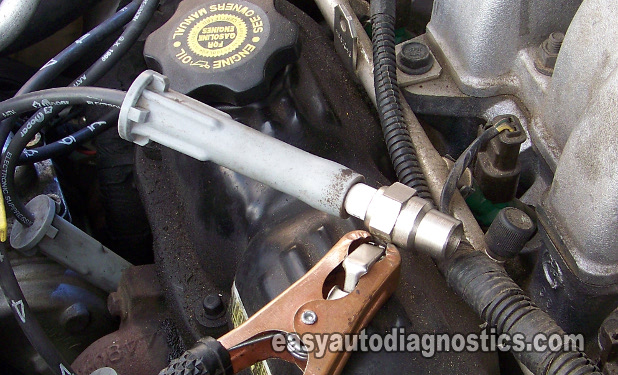STEP 1: Testing The Ignition System For Spark

In my opinion, the most important first test that should be done when diagnosing a no-start problem is making sure that all 6 spark plug wires are sparking when the engine is cranked.
It's very important that the spark tests should be done with a spark tester. Using any other method to test for spark might give you the wrong test result and have you chasing ghosts (and that can get expensive).
NOTE: This is a basic overview of how to test for spark. If you'd like a more detailed tutorial on how to test the ignition system check out these tutorials:
- How To Test The Coil Pack (1990-1998 Chrysler 3.3L, 3.8L).
- 1999-2001 Coil Pack Diagnostic Tests (Chrysler 3.3L).
- How To Test The Coil Pack (2001-2008 Chrysler 3.3L, 3.8L).
Let's get started:
- 1
Disconnect the #2 cylinder spark plug wire from its spark plug.
- 2
Connect the spark tester to the spark plug wire.
- 3
Ground the spark tester. My preferred method is to connect the spark tester to the battery negative (-) post with a battery jump start cable.
- 4
Have your helper crank the engine as you observe the spark tester from a safe distance.
- 5
The spark tester should spark as your helper cranks the engine.
- 6
Repeat this test on the remaining cylinders.
Let's interpret your spark test results:
CASE 1: Spark is present at all 6 spark plug wires. This is the correct and expected test result.
With this test result you can conclude that:
- The crankshaft position sensor is good.
- The camshaft position sensor is good.
- The ignition coil pack is good.
Your next step is to test the fuel pump's pressure. For this test go to: STEP 2: Testing The Fuel Pump's Pressure.
CASE 2: You got NO spark at all 6 spark plug wires. This test result tells you that the engine is not starting due to a lack of spark.
The components that can cause this are:
- A bad crankshaft position sensor.
- A bad camshaft position sensor.
Your next step is to test the crankshaft position sensor and camshaft position sensor. The following tutorial may be of help: Crank Sensor Test -No Spark No Start Tests (3.0L, 3.3L, 3.8L).
STEP 2: Testing The Fuel Pump's Pressure

Once you've eliminated the ignition system as the cause of the no-start problem, the next step is to test the fuel pump.
The fuel pump is testing by doing a simple fuel pump pressure test with a fuel pressure test gauge.
This fuel pressure test gauge is connected to a Schrader valve (on the fuel injector rail) to read the fuel pump pressure output.
Now, since this tutorial covers so many model years of the 3.8L V6 Chrysler, Dodge, and Plymouth mini-vans, I have not included the actual fuel pressure specification for each mini-van.
You'll need to Google or look in the repair manual to find the fuel pressure specification for your particular application.
NOTE: If you don't have a fuel pressure tester and need to buy one, take a look at this section: Where To Buy An HEI Spark Tester And A Fuel Pressure Gauge.
Let's get started:
- 1
Place a shop towel around the Schrader valve. The shop towel's job is to absorb any fuel that may leak when doing step 2.
- 2
Connect the fuel pressure gauge to the Schrader valve on your mini-van's fuel injector rail.
- 3
When ready, ask your helper to cycle the key ON and OFF but don't crank the engine while you observe the fuel pressure tester's gauge.
Check the connection at the Schrader valve for fuel leaks and if any tighten the fuel pressure a bit more (by hand only) to eliminate them. - 4
Crank the engine and check the fuel pressure gauge. Your fuel pressure gauge should register the specified fuel pressure.
Let's take a look at your fuel pressure test results:
CASE 1: The fuel pressure test gauge registered 0 PSI. This confirms that the no-start problem is caused by a lack of fuel.
This usually means that the fuel pump is bad and needs to be replaced.
CASE 2: The fuel pressure gauge registered the indicated fuel pressure specification. This fuel pressure gauge result lets you know that the fuel pump is working and delivering enough fuel to the fuel injectors. You can conclude the fuel pump is OK and not behind the no-start problem.
The next test is a compression test. Go to: STEP 3: Checking For A Blown Head Gasket.
CASE 3: The fuel pressure is lower than the indicated PSI. This tells you that the fuel pump is defective.
